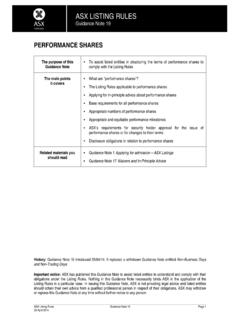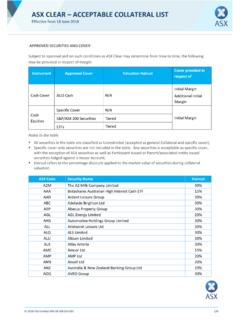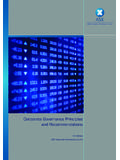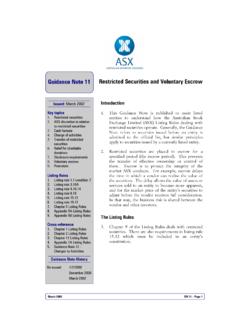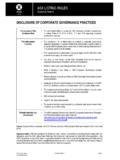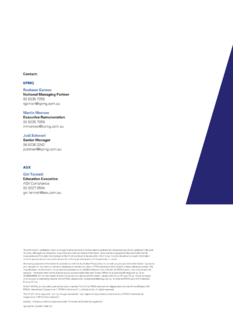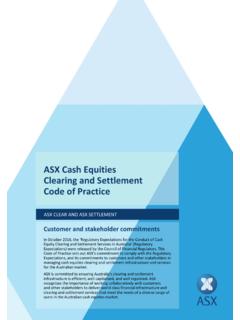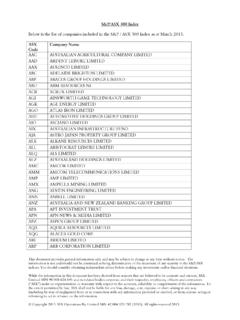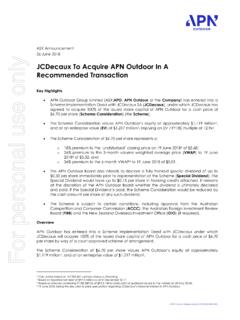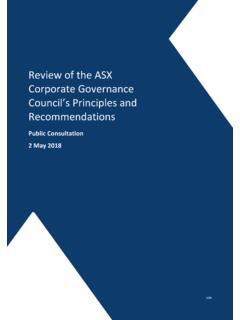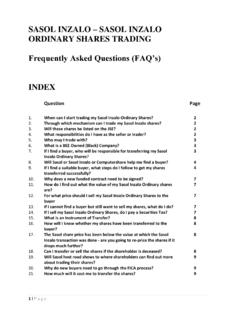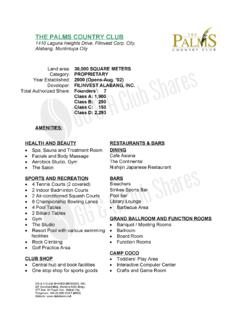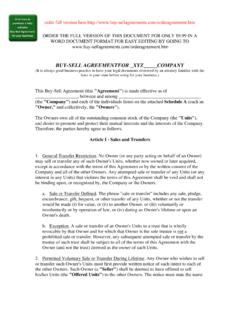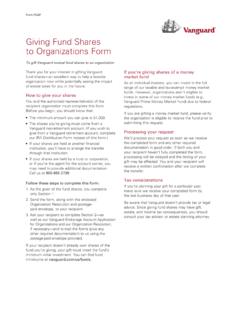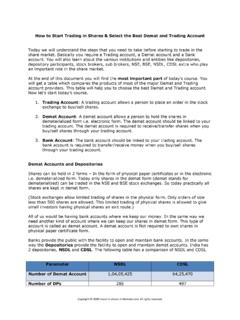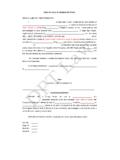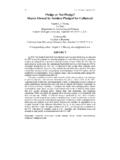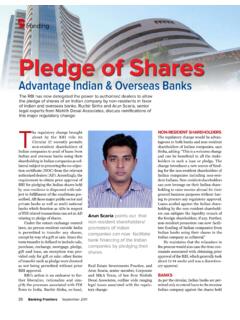Transcription of Getting Started in Shares - Australian Securities …
1 Getting Started in Shares ASX. The Australian Sharemarket Disclaimer of Liability Information provided is for educational purposes and does not constitute financial product advice. You should obtain independent advice from an Australian financial services licensee before making any financial decisions. Although ASX. Limited (ABN 98 008 624 691) and its related bodies corporate ( ASX ) has made every effort to ensure the accuracy of the information as at the date of publication, ASX does not give any warranty or representation as to the accuracy, reliability or completeness of the information. To the extent permitted by law, ASX and its employees, officers and contractors shall not be liable for any loss or damage arising in any way (including by way of negligence) from or in connection with any information provided or omitted or from any one acting or refraining to act in reliance on this information. Copyright ASX Limited No part of this brochure may be copied, reproduced, published, stored in a retrieval system or transmitted in any form or by any means in whole or in part without the prior written permission of ASX.
2 Reprinted March 2001. Revised June 2001. Revised November 2001. Rewritten March 2004. Rewritten January 2006. Revised March 2007. Revised September 2008. Revised May 2010. Revised November 2011. Rewritten 2014. ASX and CHESS are registered trade marks of ASX. S&P is a registered trade mark of The McGraw-Hill Companies, Inc. Exchange Centre, 20 Bridge Street, Sydney NSW 2000 Telephone: 131 279 Contents Thinking about investing 2. What is a share? 3. Three steps to investing in the sharemarket 4. 1 Getting ready 4. 2 Investing how to buy and sell Shares 6. 3 Getting better 16. 1. Thinking about investing When you turn your mind to the prospect of investing in the sharemarket there are a lot of things to consider. Consider why you want to invest in the market We will touch on the importance of having what are your investment objectives? objectives and a plan but it won't be the central theme. There are many resources that you can Consider whether these objectives are sound draw on to assist you including the free courses, and realistic and how you are going to achieve email newsletter and sharemarket game we them.
3 This goes to mapping out your investment provide on our website There are strategy. also many books, magazines and newsletters Then there are the practicalities of actually on investing that are available. investing of doing it. People often get a bit The primary purpose of this brochure is to get you overwhelmed because for many the sharemarket ready for investing in Shares in a practical sense. is unfamiliar territory with unfamiliar language. This brochure is intended to give you what you And of course, once you have bought some Shares need to know in clear language that is easy that is just the start of the journey. You will want to understand. to know how your Shares are performing and how you can build on your investing skills. We'll give you some suggestions on the resources you can use. Objectives How do you find a stockbroker that suits your needs? How do you set up an account with a broker? If you are talking to an adviser, what are they likely to ask you? What is all the paperwork about?
4 After you have bought some Shares , what happens next? 2. What is a share? Tell me, what is a share? . If someone walked up to you in the street and asked: You might say: After explaining that a share represents a part A share represents a part ownership ownership in a business and the sharemarket is in a business. a place for buying and selling those Shares , you might be asked one final question: The more profitable that business is, the more valuable the Shares of the business become. Why would I buy and sell Shares ? . Shares are a way to trade a stake in that The simple answer is to build wealth. business with other people. You can do this in two ways: What if that person followed up with another question? buy Shares at one price and sell at a higher price, and What is the sharemarket? earn income in the form of dividends from People often don't realise they already know what your shareholding. the sharemarket is. The sharemarket is just like a A share price goes up because people value the fish market, a fruit market or a cattle market.
5 It is Shares in that company and offer increasingly a place where buyers and sellers come together to higher prices to buy them. This may sound simple, work out a price for something by bidding for it. but there is no guarantee Shares will rise in price while you own them. The tricky part about the sharemarket is that there is no physical good that can be seen, touched or The big risk of investing in the sharemarket is smelt. Also people don't come together under the owning Shares in a company that fails and its roof of a sharemarket building to trade. Today's Shares become worthless. sharemarket is an electronic one where buyers and sellers are in different locations but come together in a virtual market place to buy and sell Shares . THE MORE PROFITABLE THAT BUSINESS. IS, THE MORE VALUABLE THE Shares . OF THE BUSINESS BECOME. 3. Three steps to investing in the sharemarket 1 Getting ready 2 Investing how to buy and sell Shares 3 Getting better 1 Getting ready Investing in the sharemarket is not a guarantee Diversification of wealth in fact it is quite possible for The popular saying don't put all your eggs in one sharemarket investments to perform badly and basket can apply to many things but it applies lose money.
6 All investments carry some degree of particularly well to investing in the sharemarket. risk it is something you need to consider when assessing each and every investment. Markets move in cycles. Some investors fall into the trap of putting all their money into one asset class Take a moment to reflect on these questions: or sector usually at its peak, and then watch as What are my goals? another asset class or sector takes off without them How much money should I invest? (an asset class is an investment type like Shares or property and a sector is a particular investment Where should I invest: the sharemarket, area like Shares in banks or mining companies). bank deposits, property? It is better to diversify, spreading your risk. Many people use experienced and qualified financial The sharemarket is one asset class and there advisers to help formulate their investment goals are different sectors within the sharemarket or to test some of their ideas. This can help in you can use to diversify your portfolio.
7 Assessing how realistic these goals are and the level of risk you might expect to take on. A sound investment portfolio usually includes investments with a combination of different Risk and reward in perspective features. For example, you might hold some To get a return on an investment you must accept investments that you can convert to cash easily some level of risk. The higher the potential return, and some you are happy to have locked away the higher the risk to your funds. for a period of time. Your challenge as an investor is to know what risk your investments have and how much you are RISK. prepared to accept. What would it mean to you WORST CASE. if the worst case scenario occurred owning Shares in a company that went out of business and those Shares became worthless? $0. 4. Why do people invest in Shares ? To be entitled to a particular Capital growth dividend a shareholder must People invest in Shares because they offer the have purchased the Shares before possibility that their price will rise.
8 Investors might the ex-dividend date for that only intend holding the Shares for a relatively short term or they might have a longer term view, dividend. If you purchase Shares but in either case they hope to make a profit. on or after that date, the previous owner of the Shares (and not you). Dividend income Apart from buying and selling Shares for profit, will receive the dividend. investors also buy Shares to provide an income stream. Dividends are cash distributions from a company to its shareholders. Dividend payments are typically 22 23. paid each six months as interim' and final'. dividends. Companies are under no obligation to pay dividends and the amount a company pays in dividends can vary from year to year. In the case where you bought and then sold some Some companies pay dividends with franking Shares for a loss the capital loss can be offset credits attached. The effect of franking credits against any capital gains or carried forward if you can be to increase the after-tax benefit to the have not crystallised any profits in that tax period.
9 Shareholder. See the section on tax below. Dividends are regarded as assessable income and Companies can also offer dividend reinvestment you can be taxed on them. As mentioned above, plans. Rather than receive a cash payment, you dividends from Shares are sometimes paid with can use the dividend amount you receive to buy franking credits attached. Franking credits pass on new Shares in the company. the value of any tax that the company has already paid on its profits. The price of a share will often fall by approximately the dividend amount when the Shareholders can receive an imputed' credit with share goes ex-dividend . To be entitled to a their dividends. Dividends can be fully franked particular dividend a shareholder must have (100%) to the extent of the company tax rate, purchased the Shares before the ex-dividend date partially franked or unfranked. for that dividend. If you purchase Shares on or The benefit of franking credits is their potential after that date, the previous owner of the Shares to increase your after-tax returns.
10 (and not you) will receive the dividend. Stamp duty and GST do not apply to the purchase Tax and Shares or sale of listed Shares . However, GST will be Investing in Shares has tax implications. The imposed on brokerage fees associated with such purchase and profitable sale of a share investment transactions. will usually incur capital gains tax. Please be aware that tax policies can change. One benefit of share investing is it can offer You should always consult your accountant concessional capital gains tax. In most circumstances or other professional taxation adviser. the capital gains tax payable may be discounted by 50% for Shares sold 12 months or more after The website of the Australian Taxation Office the date of acquisition. This means only half of the will explain the current policies applying to capital gain is included in your assessable income. tax on share investments. PEOPLE INVEST IN Shares BECAUSE THEY OFFER. THE POSSIBILITY THAT THEIR PRICE WILL RISE. 5.
